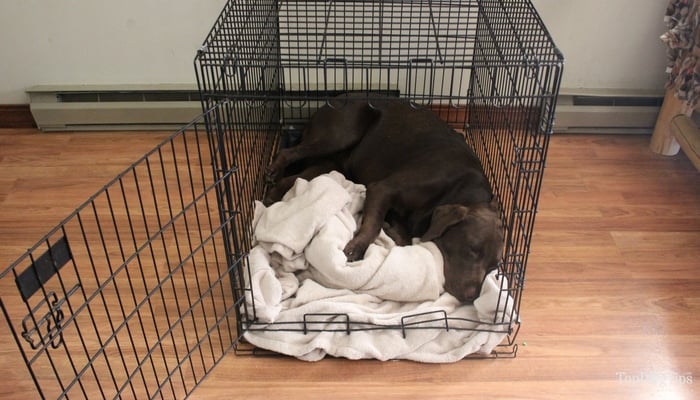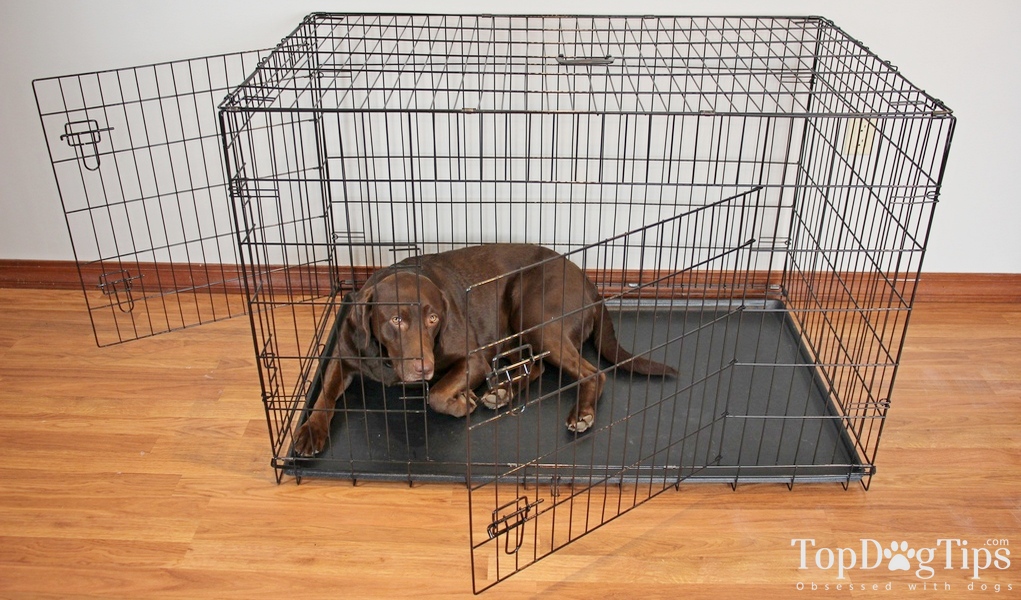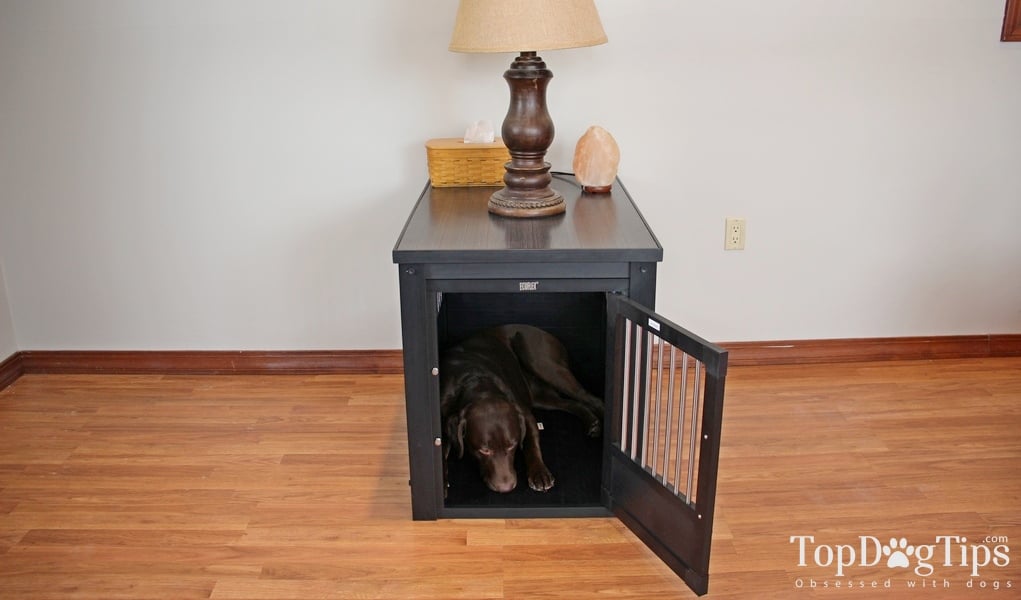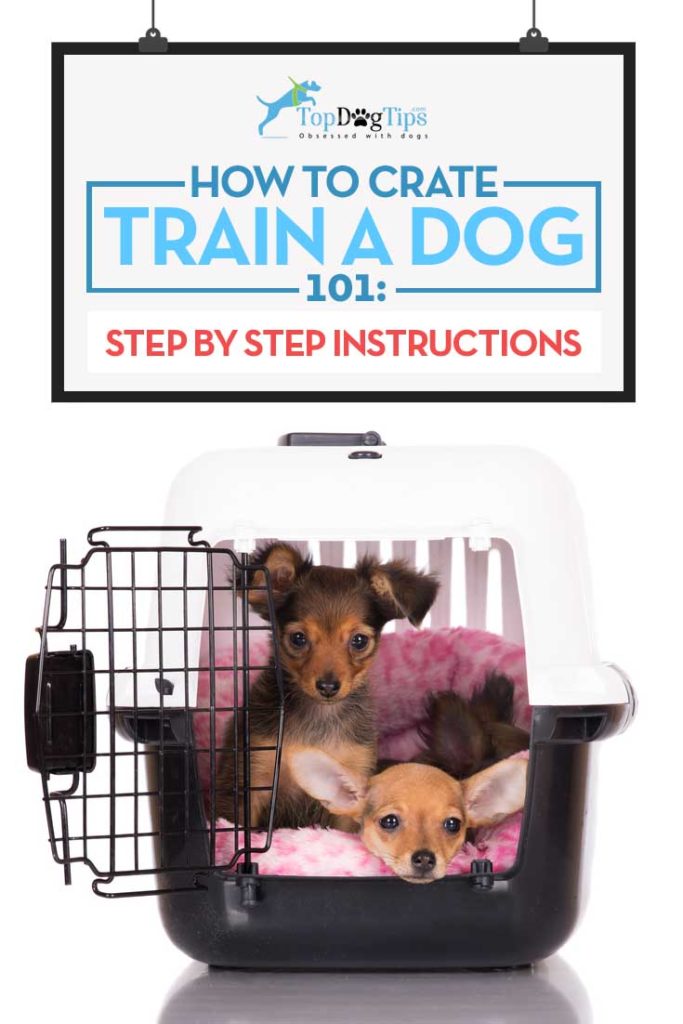Crate training is not always a negative experience for dogs. While they are not naturally den animals, they do have a tendency to love staying in dog crates. Ultimately, learning how to crate train a dog effectively is an excellent way to keep your pet safe and provide him with an area in your home where he can feel comfortable.
Table of Contents
You should think about crate training a dog before you even bring your new pet home. It should not be a practice that you plan on using to contain your dog throughout the course of his life or to punish him. The primary use of pet crate training is house breaking. On top of that, dog crates can also be very handy when traveling with a dog or letting your anxious pet hide away during thunderstorm or fireworks.
Dogs do not like to use the bathroom in their den, or in this case, their crate. Learning how to crate train a dog and picking the a good soft crate (or a metal crate) will also protect your belongings from being chewed by a rambunctious puppy. It's something that every pet owner usually must go through, and those who avoid crate training early usually regret it.
Majority of dogs love being in their crates (though some do not). Generally, crating dogs gives your pet a place where he can be in peace and have his own space and it reduces the number of messes you'll have to clean up. Learning how to crate train a dog is a win-win for pet owners and their dogs, as long as you do so safely and effectively.
How to Crate Train a Dog
1. Do Not Use a Dog Crate as Punishment
If you give your dog negative connotations about his crate, he'll never want to go inside. Using dog crates as punishment is the easiest way to get your canine to associate them with negativity and having the dog to avoid and be scared of them in the future.
If your dog does something naughty, DO NOT send him to his pet crate. Designate a time out area for your dog to go into when he needs time away. If Fido begins to view the dog crate as a punishment, he'll never want to go in there willingly.
Speaking of willingness to go in the crate, DON'T force your dog to enter the crate either. Forcing him to enter will only make him fear the crate more. Your pooch must go into his dog crate out of his own volition and stay there for that same reason, too.
It's also not a good enough reason of learning how to crate train a dog because your pet has separation anxiety. Placing your dog in a small, confined space when he is nervous will likely add to his anxiety and make the situation only worse. Furthermore, your pet may try to escape the dog crate, causing injury to himself in the process.
2. Introduce the Dog Crate First
After you measured the dog and then picked the right type of pet crate, it's time to gradually introducing your pooch to it. Set up the dog crate in a common area of your home.
As you'll see in my video above, we have ours set up in the living room. For the first few days that your dog is home, leave the door of the dog crate open at all times and allow him to explore it freely on his own.
Remember that forcing your dog into the crate will only make things worse. Let's say you set your dog's crate up in the living room too. Spend time in there relaxing, watching television or reading a book to let the dog see that you're hanging out there.
Eventually, your pooch will begin to sniff the outside of the dog crate and will likely work his way to the inside. He may seem hesitant at first, but most dogs will explore the crate on their own. For some pets, it takes time for them to take a liking to their dog crates.
If he doesn't go in on his own after a couple of days, try to entice him in with a positive reward. Place treats in the entry way of the crate and then move back. He may take the treats slowly at first, but as his courage grows you can start placing the treats further back.
3. Feed Your Dog Inside the Crate
When you're just learning how to crate train a dog, feeding him inside his dog crate is a good place to start. Obviously dog food is going to be a major motivator for your pup, and he'll begin to associate the crate with one of the positive things in his life – dinner!
Use the same voice command every time you want your dog to enter his puppy crate, even if he doesn't go in all the way yet. Some people like “go to bed” or “go to your crate” as commands. Whatever you choose, just make sure you use the same verbal cue each time. It's an important part of proper dog command training.
Say the cue and then place his food inside the dog crate. As I mention in the video guide above, if your pet isn't comfortable entering the pet crate you'll want to begin by placing his dog food in the entry of the crate.
As your pooch begins to get more comfortable with the crate, you can start moving further in until eventually he is eating in the back corner of the kennel.
When you're just beginning to crate train your dog, don't shut the door while your canine is eating in the dog crate. For the first few days, you'll want to feed your pet all his meals inside the pet crate, and leave the door open.
This will allow him time to adjust to being inside the crate without fearing that he is trapped. You'll notice that your dog is becoming more comfortable in the crate over time. Once you feel that he is relaxed when eating his dinner in the crate, you can begin to close the door while he is eating.
4. Gradually Increase Time Spent in the Dog Crate
At first, only close the door while your dog is eating in the crate. Once he's finished, open the door and show him that he isn't stuck in that crate.
You can gradually begin leaving the door closed for longer periods of time, and you'll need to be consistent. Consistency is key to all types of effective dog training techniques.
Begin by leaving the dog crate closed for 2 minutes after eating. Then increase to 5 minutes, then 10, and so on until your dog is able to stay in the crate without whining for up to 30 minutes.
If he begins to whine, DO NOT open the crate. Leave the room and ignore the behavior. Your dog needs to see that you are not going to open the crate's door just because he doesn't like it. Otherwise, he'll know how to manipulate you in the future.
Continue with the same interval of time until Fido sits in the crate without whining. For example, if you've moved up to the 10 minute mark, continue working with him in 10 minute intervals until he no longer whines.
Trust me, this will get easier as the time increases. When your dog eventually realizes that he's stuck in the pet crate for as long as you deem necessary, he'll stop whining.
If your Fido seems to have severe anxiety while in the dog crate, you may need the help of a professional trainer when learning how to crate train a dog. They can help get to the underlying issue that is causing the anxiety.
5. Crate Your Dog When You're Away from Home
Once your pooch can comfortably stay in his crate for 30 minutes with the door closed, you're ready to leave him in it while you leave the house.
Just remember that puppies under 6 months of age should not be left alone without a bathroom break for more than 3 hours. Adult dogs should not be left for longer than 6 hours in a dog crate.
If your work schedule will not accommodate this, you'll need to hire a pet sitter or a dog walker. If you're lucky, maybe a friend, family member or neighbor could help you out free of charge. If not, you'll need to budget to hire a professional.
Ultimately, learning how to crate train a dog can be very useful for most pet owners and their dogs, and is generally encouraged by experts, dog trainers and veterinarians. It's important to pick the right type and size of dog crate that fits your pooch (see a full sizing guide here) and avoid the common pitfalls, recognize them well in advance.
READ NEXT: 5 Mistakes of Crate Training Dogs (and how to fix them)
















